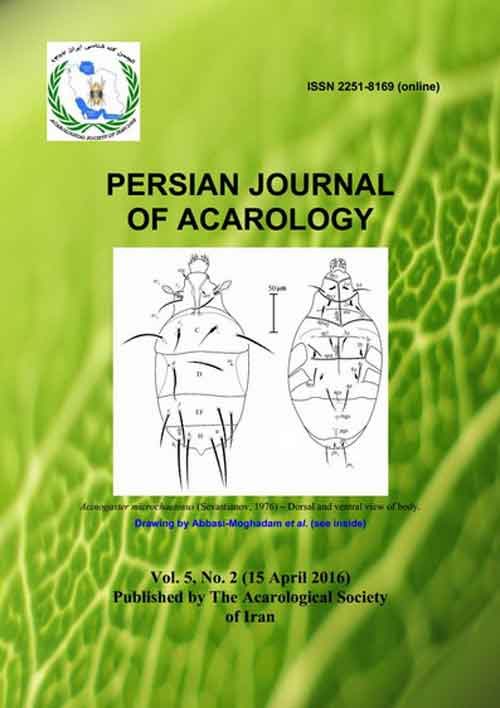فهرست مطالب

Persian Journal of Acarology
Volume:5 Issue: 2, Spring 2016
- تاریخ انتشار: 1395/03/30
- تعداد عناوین: 9
-
-
Page 89It was observed that the transverse distances between the landmark setal pairs j1-j1, j3-j3, s4-s4, Z4-Z4, and Z5-Z5 and the vertical distances between the pairs j3-s4, s4-Z4, and z4-Z5 on the dorsal shield were much less in Paraphytoseius cracentis (Corpuz and Rimando, 1966) and much higher in Paraphytoseius orientalis (Narayanan, Kaur and Ghai, 1960). However, the vertical distance between j1-j3, that were located closer to each other than other pairs, were in variation range of each other in these 2 species. Some of these measurements, especially transverse distance between s4-s4 and vertical distance between s4-Z4, may be of additional taxonomic value. Therefore, study of these features in other species of Paraphytoseius and Phytoseiidae is suggested to see if such studies are useful.Keywords: distance between setal pairs, Paraphytoseius cracentis, Paraphytoseius orientalis
-
Page 99In this study, the mite Acinogaster microchaetosus (Sevastianov, 1967) (Acari: Heterostigmata: Neopygmephoridae) associated with Tetramorium sp. (Hymenoptera: Formicidae) is redescribed based on material recovered from northern forests of Iran. It is first record of the genus Acinogaster from Asia including Iran. Distribution and host range of all 11 species of the genus is reviewed.Keywords: Ant, Heterostigmata, Iran, mite, phoresy
-
Pachyseius masanisimilis (Mesostigmata: Eviphidoidea: Pachylaelapidae), a new edaphic mite from IranPage 109Pachyseius masanisimilis n. sp. is described based on female specimens collected from soil, leaf litter and humus of fruit trees in highland areas of north part of Tehran Province of Iran.Keywords: Gamasina, Tehran, Soil, Leaf litter
-
Edaphic mites of the cohort Gamasina (Acari: Mesostigmata) in the Botanical Garden of Nowshahr, IranPage 121A faunistic survey was carried out on edaphic mites of the cohort Gamasina in the Botanical (Ecological) Garden of Nowshahr, Mazandaran Province, Iran, since winter 2015 to winter 2016. The samples were taken from habitats randomly. A total of 34 species belonging to 20 genera, 12 families and five superfamilies were collected and identified from which the genus Gamasolaelaps Berlese, 1904 and two species, G. whartoni (Farrier, 1957) and Pergamasus brevicornis Berlese, 1903, are reported for the first time from Iran. Among the collected specimens, Gamasphis lanceolatus Karg, 1987 had the highest relative frequency (20.96%) and Pachylaelaps grandis Koroleva, 1977 and Laelaspis astronomicus (Koch, 1839) with 18.78% and 18.56% frequencies, respectively, were situated in the next ranks. Furthermore, the families Laelapidae (24.23%), Ologamasidae (21.61%) and Pachylaelapidae (20.30%) had the highest relative frequencies, respectively.Keywords: Soil, inhabiting mites, Ecological Garden of Nowshahr, fauna
-
Page 131Male competition to fertilize the eggs of females would result in conflicts between the members of one sex and evolution of secondary behavioral and morphological characters. Here, we have investigated the effect of familiarity and morphological traits on Phytoseiulus persimilis Athias- Henriot and Neoseiulus californicus (Oudemans) (Acari: Phytoseiidae) mating combat and precedence. Our results showed no significant difference between the number of familiar and unfamiliar P. persimilis / N. californicus males mated first. The values of ANOVA to compare the mean length of the first leg, Palp, 2nd cheliceral segment, movable digit and spermatodactyl in prevailed familiar, prevailed unfamiliar, defeated familiar, defeated unfamiliar males in male mating precedence experiment was calculated. None of the morphological characters affected the mating precedence in N. californicus. The length of the cheliceral segments did not affect the male mating precedence in P. persimilis. Tukey HSD post-hoc test for P. persimilis showed that both the first leg and palp were significantly longer in prevailed familiar males rather than that in defeated unfamiliars. Also a significant difference was observed between the length of the palp in prevailed familiar and unfamiliar individuals. The spermatodactyl length was significantly more in prevailed familiars in comparison with defeated ones although no significant difference between prevailed familiars and defeated unfamiliars in P. persimilis. The relationship between morphological characters, mating precedence and inbreeding depression is discussed.Keywords: behavior, competition, familiarity, mating precedence, morphology

